
The interest in gluten in Singapore has increased by almost 900% in the last decade according to Google Trends. But what is gluten? We know it’s something to do with food. We know that it’s not good for some people. But do we know what it is and should we even care? Have you been sitting on a fence umming and ahing about whether to exclude gluten/wheat/grains from your diet but are paralysed with indecision? Worry no more! We’re going to reveal all in today’s article in clear, simple and plain language liberally sprinkled with science, ancestral wisdom and a large dollop of common sense. First lets get down to basics.
What is gluten?
Gluten refers to a group of proteins that are found in cereal grains.
What is a protein?
Proteins are one of the 4 macronutrients that make up the entire contents of food; protein + fat + carbohydrates + water.
What are cereal grains?
Cereal grains are the seeds (babies) of grasses such as wheat, rye and barley.
What foods typically contain gluten?
Well gluten is most commonly found in wheat flour which is used in so many processed food products including cereals, breads, pasta, pizza, cookies, cakes, noodles, porridge, crackers, biscuits, muesli, pancakes, pies, pastries, polenta, semolina, muffins, rolls, doughnuts, gravy, soy sauce and other commercial sauces, deep fried foods, dumplings, dim sum, soba, tempura, processed meats and beer. For most of this article we'll be referring to "wheat" as a proxy for gluten and all foods containing wheat flour.
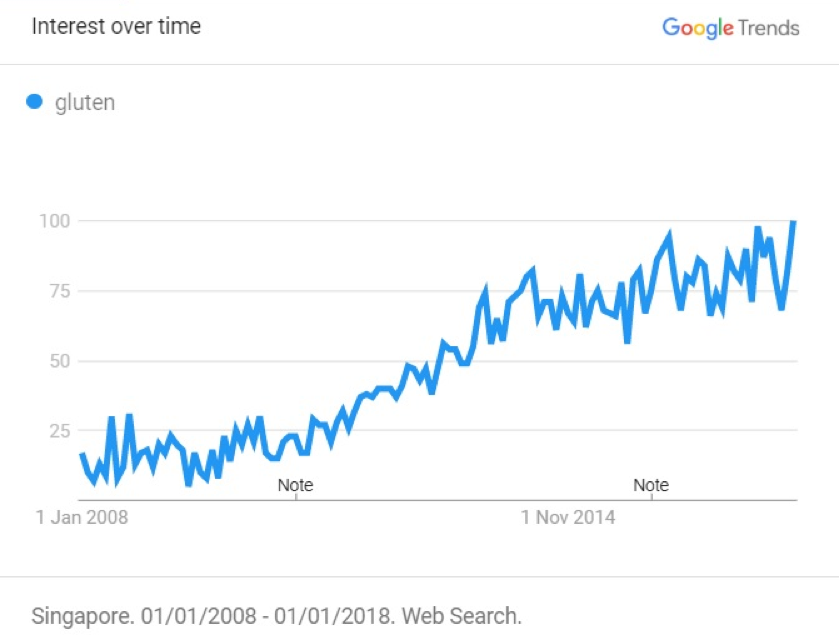
So how did all this chat about gluten come about?
Celiacs
First it started with those who are diagnosed with Celiac Disease. Celiacs have a complete intolerance to the gluten proteins that cause an autoimmune reaction. An autoimmune reaction occurs when the body attacks itself thinking, for example that, parts of your small intestine need to be destroyed. This leads to diarrhoea, abdominal distention, malabsorption, loss of appetite, failure to thrive in children and can lead to cancers if left untreated. The only known treatment is a gluten free diet. As many as 1 in 40 people have Celiac disease in some parts of the world and up to 80% of people are undiagnosed.
Paleo
Next up we had the paleo movement 1.0 which pretty much advocates that eating anything post the agricultural revelation (processed foods, grains and beans) is not an optimal human diet. Paleo 3.0 has softened the stance but the principles still remain. We could also add biohackers and the anti-aging crowd to this group who also eschew gluten for similar reasons.
NCGS
Next up we have non-celiac gluten sensitivity. These are people who are not Celiac but have had food intolerance tests performed that have determined that they have either gluten intolerance or gluten allergies. We can also put in this bucket those people that gave up gluten and just feel a whole lot better after doing so.
So these are the 3 main contributors to the gluten free movement and why you are increasingly hearing about gluten free in the press, seeing more gluten free products in the supermarkets and seeing gluten free options in the restaurants. By all accounts all 3 groups seem to be growing at a rapid pace so I think we can safely say that the movement is not a fad but something here to stay.
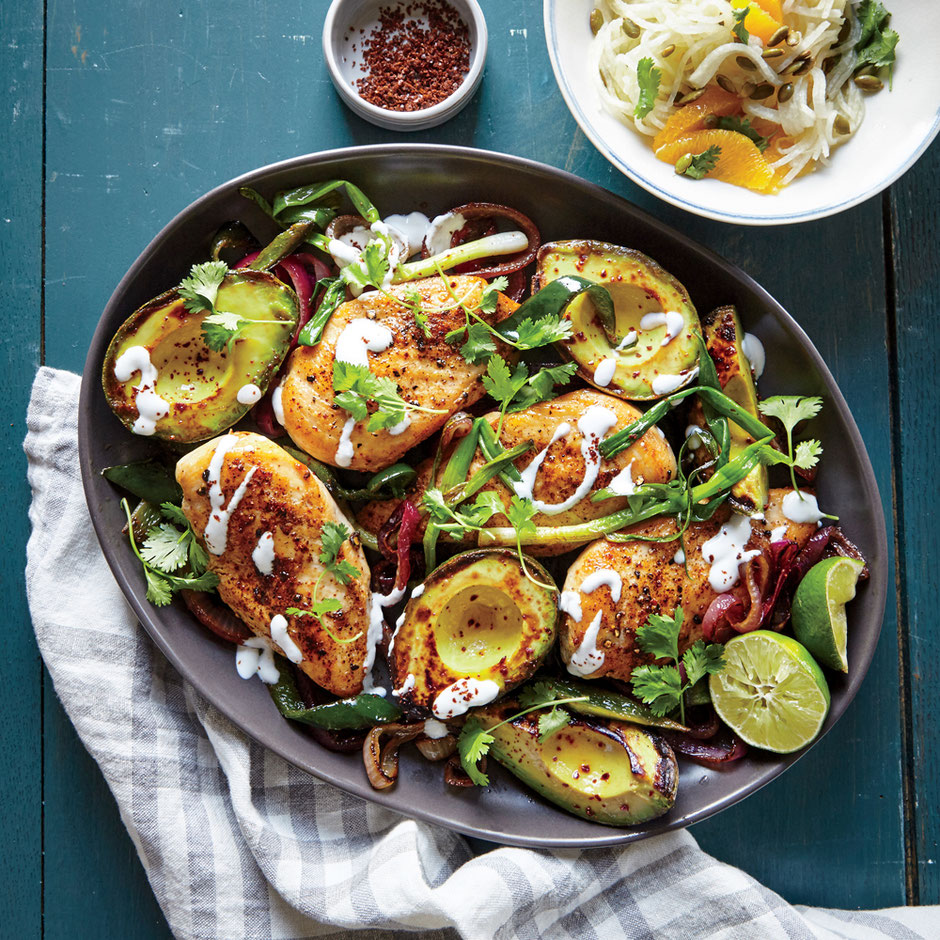
So why is our food supply trying to kill us? Why gluten? Why not broccoli or sardines? Why is gluten so bad?
Good question. And to understand the answer we need to understand the nature of natural plant toxins. Nuts, seeds, beans and grains are the babies of trees, plants, legumes and grasses. They don’t want to be eaten and consumed because if they were the species would not be able to propagate and would become extinct. So all plants developed “anti-nutrients” or plant toxins to protect them.
Phytic acid
For example, all of these plant babies contain phytic acid which binds the nutrients to the seed so they won’t be absorbed in the guts of birds, rodents and other animals that consume nuts and seeds. They don’t want their babies to be eaten so have developed methods to prevent their absorption! Phytic acid has a strong binding affinity to minerals such as calcium, magnesium, iron, copper, and zinc so in addition to tying up nutrients in the seed they can further bind up additional minerals consumed at the same time as the phytic acid containing seed.
|
Did you know? Farmers have known the problems of phytic acid for a while and how it causes nutrient deficiencies in livestock when fed an unnatural grain based diet (as opposed to a natural grass diet). Hence animal feeds are fortified with Histidine acid phosphatases (HAPs)1 and phytase enzymes which help predigest the feed for the animals. Birds and rats don’t have the same problem as they produce 30 times more phytase enzymes (the tools required to breakdown the tightly bound up phytic acid bundles in nuts, grains and seeds) than humans. Presumably that’s why farmers spends so much time picking out dead mice, moles, rabbits and small birds out of the jaws of their combine harvesters that live and feed in grain fields. |
||
Lectins
Similar to phytates, plants produce lectins that bind up starchy carbs in plant babies as an additional way to prevent them from being consumed. They tend to be more prevalent in grains and beans (the babies of legumes). The effect they have on the body is to cause intestinal damage2, cellular death and compromised intestinal villi (the small hairs in your small intestines that absorb minerals and vitamins and bring them into your body).
Gluten
Gluten is an indigestible protein found in wheat, barley, rye and oats. Again it’s a type of storage protein that binds up the nutrients until the seed has been planted in the soil and fed with water and started to sprout. Due to its indigestibility and small size it can pass through the small intestine from “outside” your body to “inside” as demonstrated in a 2009 paper that showed the presence of high levels of non-degraded gliadin (a component of gluten) in breast milk from healthy mothers3. The problem occurs as your microvilli are slowly eroded by over-consumption of gluten which begins to break down the tight junctions that separate your gastrointestinal tract from your body. These slowly open up and the walls of your intestines start leaking food particles into your bloodstream. This is also known as leaky gut.

|
Did you know? Everything you eat is technically still outside your body. The inside of your gastrointestinal tract (the tubing that runs from mouth to anus) is outside your body. One of the jobs of the GI tract is to convert the food we consume into recognisable forms that the body can assimilate once on the inside. For example, proteins need to be broken down into smaller peptides and amino acids that the body can recognise. Any food particle that enters the body through the GI tract’s epithelium that has not been broken down will be tagged and bagged by the immune system as an invader.
|
History of grain consumption
It’s hard to discuss gluten without looking at the history of grain consumption in the human race. Humans have been around for somewhere between 2 million and 700,000 years and in our modern form as homo sapiens for 315,000 years as we discussed in our article on diabetes www.levitise.com.sg/how-can-singaporeans-reverse-type-2-diabetes/. We started eating grains as part of the agricultural revolution almost 9000 years ago. We were inherently much smarter back then and in tune with our bodies which is why we develop food preparation and cooking methods to not only breakdown plant toxins such as phytates, lectins and gluten but also to make the nutrients more bioavailable. For example, by properly soaking brown rice you can reduce the amount of phytic acid in it by 96%4. By grinding whole grains and creating sourdough the wild yeast and bacteria predigest and break down some of the carbohydrates and proteins (such as gluten) and creating a much more tolerable and beneficial product.
The problem with modern grains and gluten
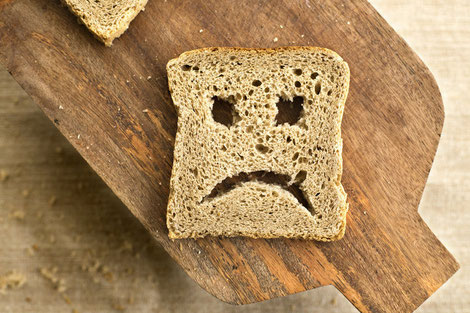
Since the invention of modern steel mills, the use of refined white flour that doesn’t contain the germ or bran, has exploded in the last 100 years. This is far more transportable and can be preserved longer than ground whole flour. It has a higher concentration of gluten (great for baking light and fluffy breads) and is far more readily absorbable. The downsides are that it is nutrient deficient, very fattening, laced with man-made toxins and plant toxins as we discussed here www.levitise.com.sg/high-blood-pressure-singapore/ and in the diabetes article linked above.
Also due to selected breeding and GMO (genetically modified organism) crop manipulation, refined flour contains even more gluten than heritage grains in order to make them even more light and fluffy. There are also claims that increasing gluten increases their addictiveness as we’ll see below. Whether ‘Big Agra’ were aware of this or not is up to you to decide but we know for a fact that caffeine is addictive and found in coke and it’s certainly not there to add to the flavour but to increase sales.
So in summary what kind of problems can we get from eating gluten in much higher quantities than we were genetically designed to consume? Well we can start off with Wikipedia. Wikipedia is very much in favour of the status quo and ‘science’ based evidence in so far as anything that hasn’t had a multitude of double-blind placebo controlled clinical trials thrown at it is dismissed outright as ‘quackery’.
Let's see what they have to say, “Gluten can trigger adverse inflammatory, immunological and autoimmune reactions and is responsible for a broad spectrum of gluten-related disorders, including coeliac disease, non-coeliac gluten sensitivity, dermatitis herpetiformis, gluten ataxia and other neurological disorders.” But if we add to that list all the other disorders as reported by functional medical doctors, naturopaths, nutrition and lifestyle coaches, nutritionists and allied health professionals we have:
- bloating, gastroesophageal reflux disease, iron-deficiency anemia, abdominal pain, anxiety, parietaria, flatulence, hallucinations, abdominal distension, attention deficit hyperactivity disorder, vascular dementia, adenocarcinoma and lymphoma of the small bowel, myorhythmia, eating disorders, dermatitis (eczema or skin rash), graminaceae, paroxysms, opsoclonus myoclonus syndrome, palatal tremor, nausea, joint and muscle pain, constipation, rhinitis, allergies, folate deficiency, foggy mind, restless legs syndrome, lactose intolerance, epilepsy, aerophagia, peripheral neuropathy, dystonia, parkinsonism, depression, fatigue, asthma, migraine, leg or arm numbness, myoclonus, encephalopathy, aphthous stomatitis, chorea, dyskinesia, autism, gluten ataxia, malabsorption, tingling of the extremities, diarrhoea, dermatitis herpetiformis, tourette syndrome, schizophrenia, mouth ulcers, irritable bowel syndrome, myokymia and fibromyalgia.
Actually I got these also from Wikipedia. I was quite surprised they listed so many! So let’s say that what you’ve read so far has made you want to give up gluten, or maybe cut down, or maybe make it more tolerable for you in someway. What are the options open to you and what are the problems associated with them?
Quitting gluten
So you’ve decided to bite the bullet and quit completely. Why is it so difficult to do? If we said, “can you give up broccoli for a week” would it pose the same stumbling blocks? There are a number of reasons why giving up gluten is so difficult and here’s a quick run down why.
Abundance
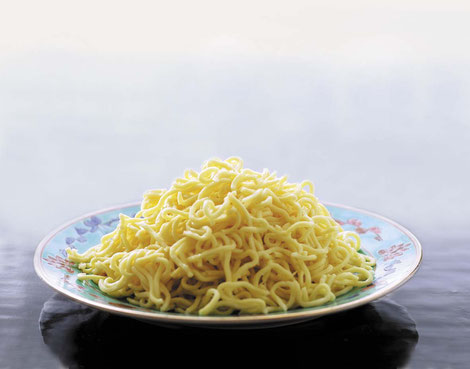
Gluten is in wheat flour which is one of the top 10 most traded commodities in the world. As mentioned previously it’s in everything including breakfast cereals, breads, pasta, pizza, cookies, cakes, noodles, porridge, crackers, biscuits, muesli, pancakes, pies, pastries, polenta, semolina, muffins, rolls, doughnuts, gravy, soy sauce and other commercial sauces, deep fried foods, dumplings, dim sum, soba, tempura, processed meats and beer.
Avoiding it is very hard.
Maybe you have cereal (gluten) for breakfast, a sandwich (gluten) for lunch and pasta (gluten) and a beer (gluten) for dinner. It all adds up to an awful lot compared to what we have genetically adapted to. Asian cuisine contains far less wheat than Western dishes as the main starchy carbohydrate is rice (gluten free) as opposed to wheat flour. But we’re seeing that change, particularly in Singapore, with the influx of Starbucks, pizza joints, bread talks and a multitude of other cafes selling wheat based products. Not to mention wheat based noodles (yellow noodles) taking the place of rice or glass noodles.
As we mentioned in our diabetes article, wheat imports in Singapore in the last 10 years have increased significantly. In fact they have more than doubled population growth indicating that Singaporeans are demanding more wheat than ever before. And that doesn’t include imported wheat based products so in reality consumption will be even higher maybe 2.5X. Coupled with that we’re seeing an increase in auto-immune disorders, particularly in our children, such as asthma, eczema and environmental allergies. Now correlation doesn’t imply causation but it’s another piece of evidence that could be used to support our case. Anyhow when wheat and gluten are this ingrained into our food system and culture, then avoiding it is pretty tough.
Replacements
Replacing wheat in Singapore is much easier than in the West. The straight replacement is obviously rice. However, it still limits your options at hawker centres and certainly at most western based cafes and not to mention Italian restaurants! Other replacement options are sweet potatoes, potatoes, cassava, yam, rice vermicelli noodles and of course the gluten free cakes and cookies market which is exploding rapidly but these processed and packaged foods are hardly optimal.
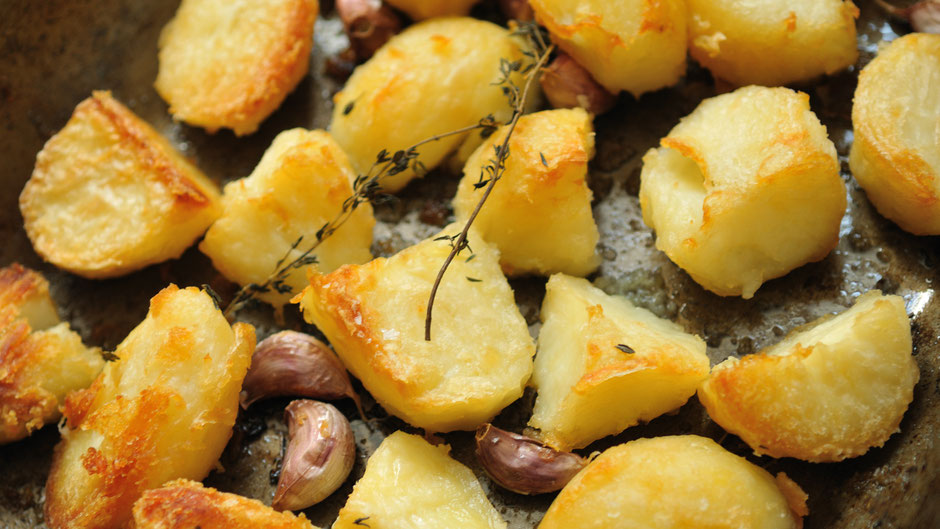
Addiction, denial and awareness
Another reason for not quitting gluten is addiction, denial and awareness which I have packaged up together because they’re all so correlated. Gluten can be degraded into several morphine-like substances, named gluten exorphins. These compounds have proven opioid effects and could mask the deleterious effects of gluten protein on gastrointestinal lining and function5. What this means in common speak is that gluten releases happy brain chemicals that reinforces the behaviour. This of course comes coupled with denial. Often even if people have a gut feeling that something is bad for them (too much coffee, alcohol etc.) they intellectually deny it to themselves so they can continue to self medicate with the offending substance. And lastly, awareness. After continually bombarding our bodies with allergenic and inflammatory foods, like gluten, we increasingly down regulate our pain sensors and internal messengers that provide us with the information required to make the decision about whether something is good, or bad for us. In a nutshell we’re just not in touch with ourselves any more.
Time
Grabbing a bowl of cereal in the morning, a quick sandwich at lunch and even boiling a pot of pasta or noodles in the evening is all pretty easy. Brewing up chicken porridge for breakfast, sitting down to enjoy a plate of steamed sea bass, whole grain rice and bak choy for lunch and cooking a full meal for dinner from scratch takes relatively more work. The health benefits of the latter are, of course, infinitely preferable so what it really comes down to is ‘value’. How much do you value your health above your time spent doing another things.
Expense
Wheat flour is cheap and abundant in many foods we regularly consume. It, along with rice, has helped us to grow to the whopping 7.5bn people that we have on the planet currently. I’m not sure if we’d have hit 7.5bn on foie gras, truffles and abalone! Eschewing wheat can mean a moderate increase in expenses as you are more likely to have to plumb for more expensive balanced meals rather than quicker snack type meals. However again this really comes down to value and if you’ve read this far this is less likely to be a hurdle for you!
Culture
Food and culture are inextricably linked and in cultures in Europe wheat and gluten containing products are a big part of the culture, particularly in Europe: crusty white French baguettes, freshly made Italian pasta and of course English pies. You can see this increasingly in the youth in Singapore now who can’t go to a coffee shop and have a tea/coffee/drink without ordering some kind of massive cake on the side to share! And likewise who could go for an Indian without ordering a naan or chapati. When removing these foods from our diet, we’re in danger of removing additional cultural enjoyment and valuable shared experiences with friends and families.
So these are all major hurdles that ensure that only those with the most severe symptoms, or the most committed, will embark on this route.
I want to live forever!

So let's say you have no health problems at all but you’re looking for an optimal eating strategy to maximise the health for you and your family. This particularly applies to those of you in the anti-aging, longevity or biohacking camps. If you are already in good health then consuming good quality wholegrain sourdough breads made from non GMO and organic heritage flours like Einkorn, Spelt and Kamut can be a beneficial part of a balanced diet. They contain no chemical fertilisers or pesticides, much lower amounts of gluten than modern flours, have more minerals and vitamins that are more bioavailable (absorbable) and have less phytates, lectins and other antinutrients. Do we think they are optimal for longevity? Probably not. How can we support that claim? Well let's have a quick look at the blue zones and see how grains were part of their diet or not.
Blue Zones are regions of the world where people live much longer than average. There are a number of things that they have in common and more importantly a number of things that they all exclude from their diets (this will be a whole article on itself in the future). In particular, it appears that large quantities of wheat flour are not a staple.
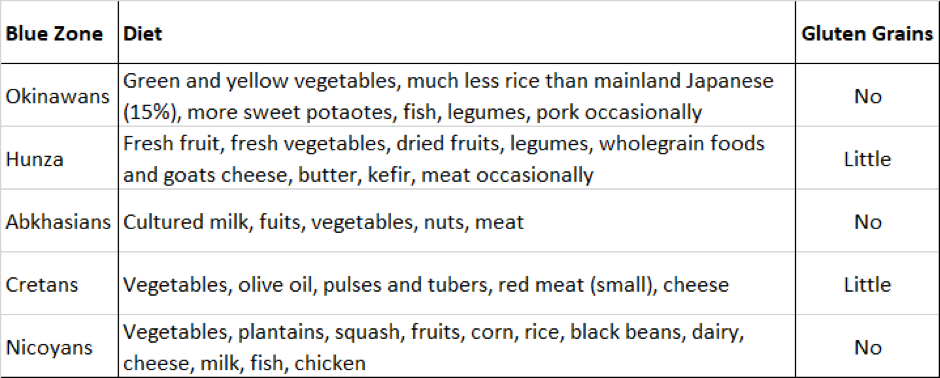
So from a longevity perspective I think a small quality amount should not be an issue.
Wrapping up
So if you’ve made it this far. Congratulations! But for those of you in the TLDR (too long didn’t read camp) who skipped right to the end you’re getting rewarded anyhow! We’ve taken wheat as a proxy for all gluten containing grains and highlighted the different types of ways of consuming it. Organic traditionally made sourdough bread being the most preferential and refined modern wheat (white flour) being the least interesting from several angles. And at the bottom you can find the category that most applies to you and pick the appropriate type of wheat and wheat based products accordingly. Maybe essentially means, “test it and see”. No is not recommended and Yes is fine (assuming tolerated).

And lastly, if you are going gluten free (and are note Celiac) but indulge in the odd buttered naan now and then or a fresh croissant, don’t sweat it – the anxiety will probably cause more harm than the gluten!
To your health, happiness and longevity,
The Levitise Team
P.S. If you love this blog post then do check out our fortnightly newsletter where you'll get the freshest content on health, nutrition and fitness delivered straight to your inbox. Don't miss out and sign up here with just your name and email.
1. https://www.ncbi.nlm.nih.gov/pmc/articles/PMC1489644/
2. https://journals.plos.org/plosone/article?id=10.1371/journal.pone.0000687
3. https://www.ncbi.nlm.nih.gov/pubmed/9867098

Write a comment